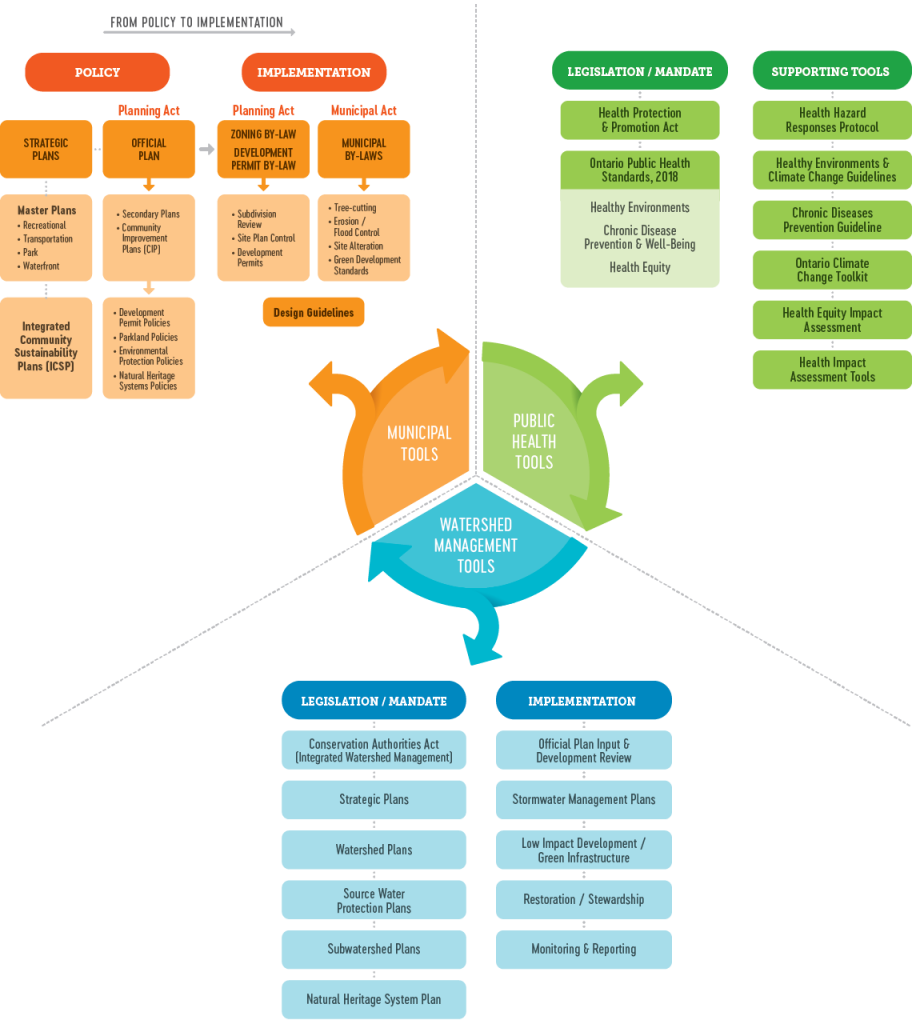Policy Toolkit
Policy Toolkit for Developing and Implementing Ecohealth Policies and Practices
Municipal governments, public health professionals and conservation authorities are in a unique position to improve community health. They have the ability to develop or influence public policies and encourage the development of practices that increase and build resilience of valuable greenspaces both in rural and urban areas. EcoHealth Ontario and partners have developed an Ecohealth Policy Toolkit to guide professionals wishing to improve community health through greenspace provision, design and access.

Here are some examples of how municipalities, public health units and conservation authorities are creating ecohealth policies and plans. See the full Ecohealth Policy Toolkit for more examples from other jurisdictions.
City of Kingston 2015 – 2018 Strategic Plan
The 2015-2018 Strategic Plan outlines the vision of “a smart and livable 21st century city”. Six priority areas: create a smart economy, invest in infrastructure, plan a livable city, green the city, advance a vibrant waterfront and foster open government; and several initiatives are listed to help realize this vision. Key initiatives under the green the city priority include: Expand the trail system; Intensify urban forest – double the tree canopy by 2025; and develop policies to prevent urban sprawl and protect agricultural lands.
City of London Parks and Rec Master Plan and Forest Strategy
The City of London is committed to building a green and healthy city. This commitment is demonstrated through the City’s focus on protecting, enhancing and managing environments that support the health and wellbeing of all Londoners. The individual and community benefits associated with a healthy environment are highlighted in several of the City’s environment-focused plans, as well as in the City’s new Official Plan.
City of London Parks and Rec Master Plan and Forest Strategy
Credit Valley Conservation is advancing the linkage between human health and greenspaces through strategic planning processes as well as innovative programming. This multi-pronged approach acknowledges the need to address complex, inter-related issues such as ecohealth through multiple channels and tools and by involving internal and external audiences.

VISION 2051: York Region’s Long Term Strategy
The 2015-2018 Strategic Plan outlines the vision of “a smart and livable 21st century city”. Six priority areas: create a smart economy, invest in infrastructure, plan a livable city, green the city, advance a vibrant waterfront and foster open government; and several initiatives are listed to help realize this vision. Key initiatives under the green the city priority include: Expand the trail system; Intensify urban forest – double the tree canopy by 2025; and develop policies to prevent urban sprawl and protect agricultural lands.

City of Ottawa’s Strategies for Urban Greenspaces
he City of Ottawa is committed to building a well-connected network of communities that offer residents the opportunity to live, work, and play. Five integrated and complementary Master Plans (Official Plan, Infrastructure, Transportation, Cycling and Pedestrian) work together to set the vision for Ottawa’s future growth to 2031. The City’s multifaceted approach to planning prioritizes sustainable development and encourages the “greening and cleaning” of the City.

Hastings and Prince Edward Health Unit
Building Complete and Sustainable Communities: Health Policies for Official Plans (2012) is an innovative document and tool, developed by Hastings Prince Edward Public Health (formerly Hastings and Prince Edward Counties Health Unit) to facilitate the design of healthy communities. The document begins with the premise that community health is in part a function of the availability of public features and infrastructure that support physical activity.